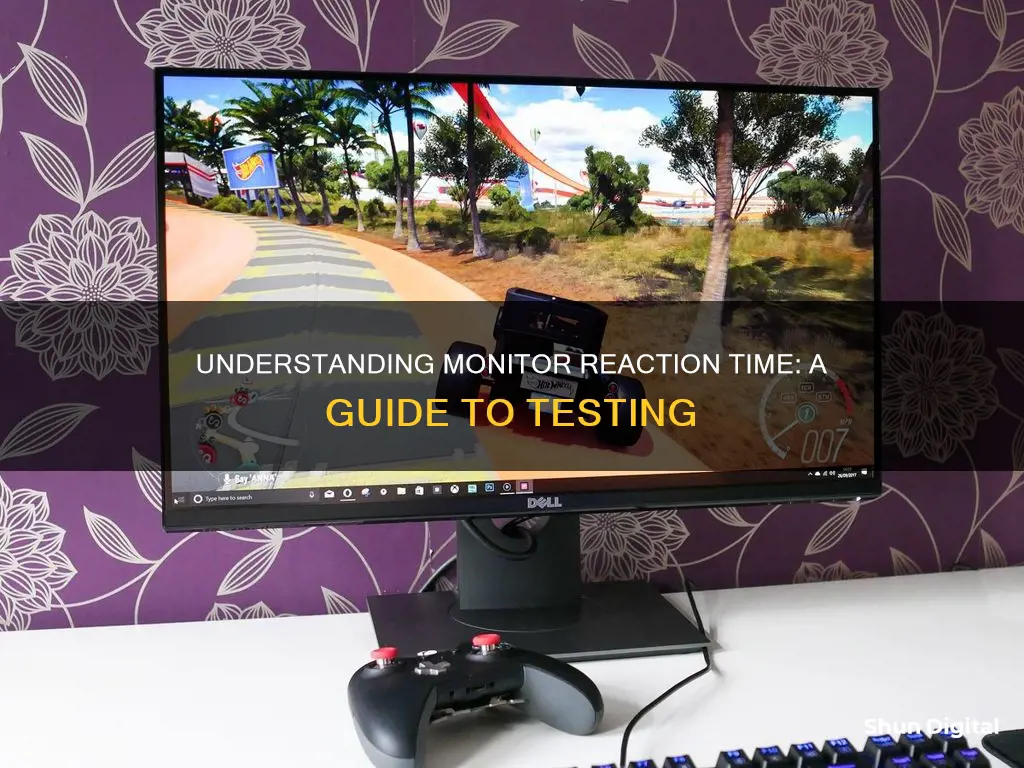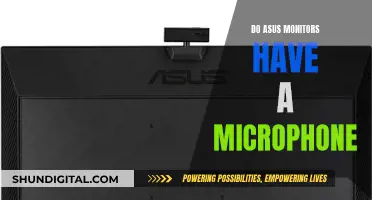
Monitor response time is a key feature to consider when choosing a monitor, especially for gaming. It refers to how quickly the pixels on the screen can change from one colour to another and is typically measured in milliseconds (ms). A faster response time results in a better visual image, with smoother and clearer visuals, and is particularly noticeable in games and media with higher frame rates. While a monitor with a slower response time may be sufficient for everyday tasks such as browsing the internet or office work, a faster response time is crucial for gamers to avoid issues such as motion blur and ghosting, which can interfere with their performance and enjoyment. To check the response time of a monitor, individuals can refer to the product specifications, conduct an online test, or utilise third-party software.
| Characteristics | Values |
|---|---|
| What is Monitor Response Time? | The time it takes for a pixel to change from one color to another and then back again. |
| How is it measured? | In milliseconds (ms). |
| What is a good response time for a monitor? | For a gaming monitor, a response time of 1 ms is considered best. However, a response time under 5ms is also good. |
| How to check monitor response time? | Review the specifications on the packaging box or on the internet. Run an online test on websites such as EIZO. |
| What happens if the response time isn't fast enough? | A slow response time can lead to motion blur or "ghosting", where images seem to leave a trail behind them. |
What You'll Learn

Monitor response time is measured in milliseconds (ms)
Monitor response time is a key metric to consider when choosing a monitor, especially for gaming or video editing. It refers to how quickly pixels on the screen can change from one colour to another and is measured in milliseconds (ms). A lower response time is better and typically ranges from 1 to 30 milliseconds for standard monitors.
For example, when transitioning from black to white and back to black, the average response time is 10ms. LCD screens, on the other hand, have response times under 10ms, with the fastest panels achieving as low as 0.5ms for certain colour transitions. TN panels are traditionally more responsive than IPS panels, but this is changing with the introduction of nano IPS.
Response time is different from the refresh rate, which refers to the number of times a monitor can update with a new image per second and is measured in hertz (Hz). A fast response time, combined with a high refresh rate, minimises motion blur and enhances the smoothness of the display. This is particularly beneficial for gamers who require clear visuals during swift in-game actions.
A higher response time can lead to motion blur or "ghosting", where images seem to leave a trail behind them, reducing the overall clarity of the display. This can be a problem for fast-paced gaming or video editing, where a lower response time of 1 to 5 milliseconds is preferred.
To check the response time of a monitor, you can refer to the manufacturer's specifications, either on the packaging or online. Online response time tests are also available, which can provide a more accurate measurement.
Monitoring Page File Size: A Comprehensive Guide
You may want to see also

Response time of 1 ms is best for gaming monitors
When it comes to gaming monitors, a faster response time is always better. The response time of a monitor refers to how quickly the display can have a pixel change from one colour to another from fully active (white) to fully inactive (black). It is measured in milliseconds, so a five-millisecond (5ms) response time means that a monitor can go from white to black to white in 1/200th of a second.
The best response time for a gaming monitor is 1ms. A lower response time means that the image will look much smoother and will 'feel' more responsive to movement, which ultimately makes a low response time better for gaming. A 1ms response time ensures minimal motion blur and ghosting during fast gameplay, providing a smoother and more immersive experience.
TN panels tend to have the fastest response times, which is why many professionals play on small TN monitors to ensure the most responsive experience possible. However, IPS and VA panels are built for better colours, which takes more processing time.
While a 1ms response time is ideal for gaming, it might not be a critical factor for all types of users. For regular office work, browsing, and content consumption, a slightly higher response time of 3ms or 5ms can still provide a satisfactory experience without motion-related issues.
Troubleshooting Black-Screen Issues on LCD Monitors
You may want to see also

Response time impacts the motion handling of the display
Response time is a critical factor that significantly influences the quality of visuals and user experience on a monitor. It refers to how quickly pixels on the screen can change from one colour to another and is usually measured in terms of going from black to white to black again, in terms of milliseconds. A typical LCD response time is under ten milliseconds, with some being as fast as one millisecond.
The response time of a monitor has a big impact on the motion handling of the display. A lower response time means that the pixels can change quickly, which is great for fast-moving content like games and videos. On the other hand, a higher response time might lead to motion blur or ghosting, where images seem to leave a trail behind them. So, a lower response time generally means smoother and clearer visuals on your screen.
When it comes to gaming, a slow response time can make faster-paced games such as first-person shooters almost unplayable, while even slower-paced but detailed games, such as real-time strategy games, can suffer from blurriness. In addition, a slow response time can make it difficult to perceive details during dynamic scenes and reduce the overall clarity of the image.
For activities that involve fast motion, such as gaming, sports, and action movies, a slower response time can lead to a less engaging and less immersive experience. The lack of visual clarity can detract from the enjoyment of such content. Therefore, it is important to consider the response time when purchasing a monitor to ensure it aligns with your specific needs.
Removing Rubber Covers from Your ASUS Monitor Easily
You may want to see also

A slow response time can lead to motion blur and ghosting
Ghosting, on the other hand, occurs when pixels don't transition quickly enough between colours, causing remnants of the previous frame to linger and overlap with the current frame. This creates a trailing or shadow effect behind moving objects, which can be distracting and reduce image quality. In gaming, ghosting can make faster-paced games, such as first-person shooters, almost unplayable, while even slower-paced games can suffer from reduced clarity.
The combination of motion blur and ghosting can blur fast action in movies and even basic movements, such as moving a cursor or scrolling a website. A slow response time can also make the display feel less responsive to user inputs, which can be a critical issue when gaming or interacting with the screen.
To minimise motion blur and ghosting, it is essential to consider monitors with fast response times, preferably 1ms or lower. Additionally, higher refresh rates, such as 144Hz or 240Hz, can further enhance the visual clarity and reduce motion blur. Fine-tuning in-game graphics settings, using high-quality display cables, and keeping GPU drivers updated can also help mitigate these issues.
Monitoring Contractions: What to Look For and How to Prepare
You may want to see also

A fast response time can lead to inverse ghosting
Monitor response time refers to how quickly pixels on the screen can change from one colour to another and is measured in milliseconds (ms). A lower response time means that the pixels can change quickly, which is ideal for fast-moving content like games and videos.
However, a faster response time can sometimes lead to inverse ghosting, also known as overshoot. This is when pixels change their colour too quickly, creating a "ghost" image in the opposite colour. This issue can be exacerbated by a monitor's overdrive setting, which is designed to improve response times by increasing the voltage applied to the liquid crystals in the display. While this can reduce ghosting and motion blur, it can also lead to inverse ghosting if the overdrive setting is too high.
To reduce or eliminate inverse ghosting, you can try adjusting the overdrive setting to a lower level or disabling it entirely. You can also try fine-tuning your monitor's display settings, such as dynamic contrast, motion blur reduction, and brightness. Additionally, ensuring that your graphics card drivers are up to date can help improve performance and prevent monitor-related issues.
It's worth noting that while a fast response time is important for certain use cases, such as gaming and viewing fast-moving videos, it may not be a critical factor for all types of users. For regular office work, browsing the internet, or watching typical videos, a slightly higher response time may still provide a satisfactory experience without motion-related issues.
Choosing the Right-Sized Monitor for Your iMac Pro
You may want to see also
Frequently asked questions
The response time of a monitor is the time it takes for pixels to change from one colour to another. It is usually measured in milliseconds (ms) and the lower the response time, the better.
You can check the specifications of your monitor on the packaging, in the user manual, or on the manufacturer's website. You can also run an online test using one of the various online tools available.
For a gaming monitor, a response time of 1ms is considered best, however, a response time under 5ms is also good. For everyday tasks, a response time of 3ms or 5ms will provide a good performance.
Response time is important for gaming and viewing fast-moving videos as it can affect the overall clarity of the image. A slow response time can cause issues such as motion blur and ghosting, where images seem to leave a trail behind them.







